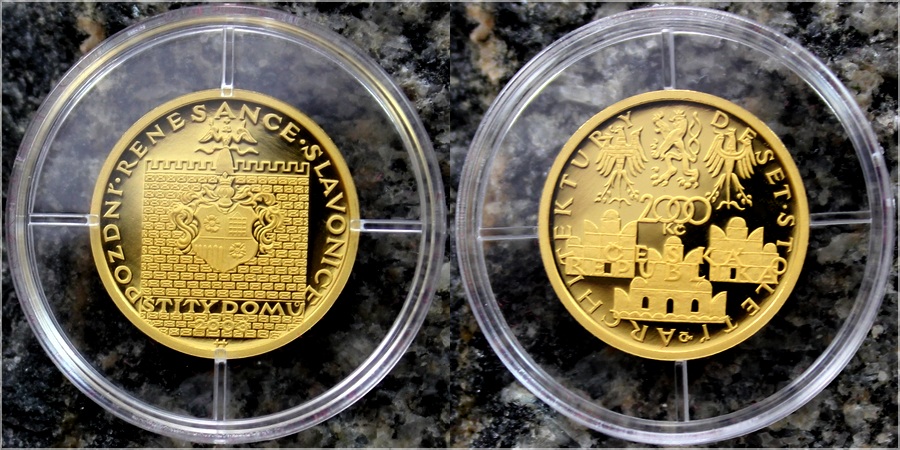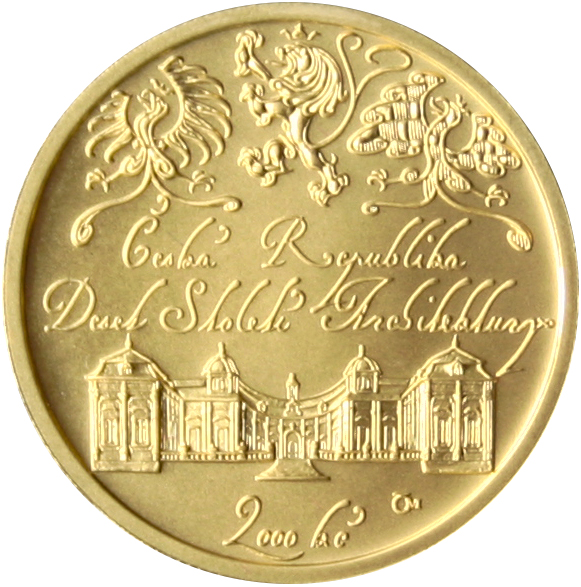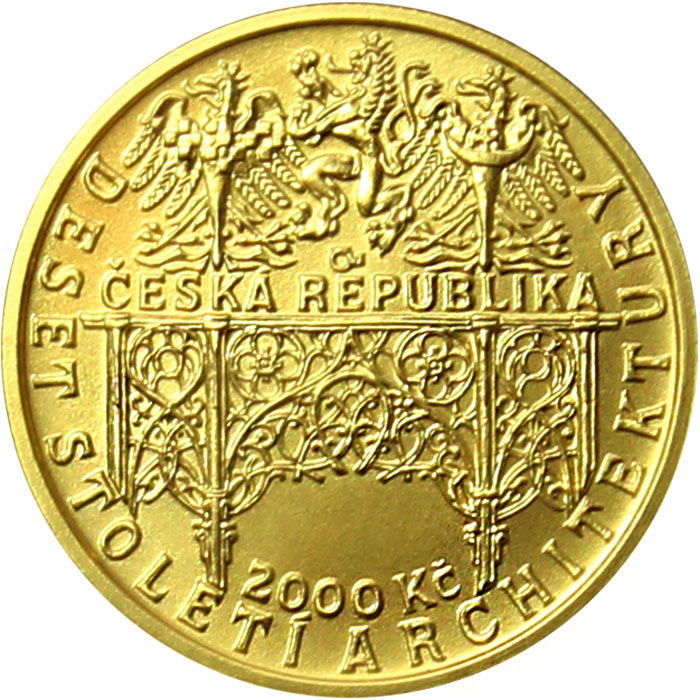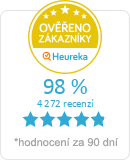Gold Coin 2000 CZK Shields Home in Slavonice Late Renaissance 2003 Standard
The product cannot be ordered now.
NOT IN STOCK
Detailed description
Gold Coin - Ten Centuries of Architecture - Late Renaissance
On the obverse side there is an artistic composition of stylized landmarks in the upper half - the Czech lion (in the middle), the Moravian eagle (left) and the Silesian eagle (right). Below this composition is the nominal value of the coin with the abbreviation of the monetary unit. In the lower part, the name of the state 'CZECH REPUBLIC' is on the background of three typical Slavonic house shields. The text "TEN CENTURIES OF ARCHITECTURE" appears in the unsealed description at the edges of the coin.On the reverse side of the coin is the coat of arms of the town of Slavonice placed against the background of a Renaissance house with sgraffito writing. The inscription "SHADES OF HOUSES" is placed across the lower part of the house and the year of minting below it. The text 'LATE RENAISSANCE OF SLAVONICE' appears in an unsealed copy at the left, upper and right margins. At the bottom edge in the middle is the initial of the surname of the author of the coin design, the academic sculptor Jiří Harcuba.
Slavonice
The first written mention of the town dates back to 1260. The original guard village, founded in the 12th century on the medieval provincial trail connecting Prague with Vienna, belonged to the property of the Lords of Hradec (golden five-leaved rose in a blue field). In the 14th century, the settlement was transformed into a town thanks to a magnificent construction. It included two squares (today named Peace Square and Upper Square), which were surrounded by medieval townhouses. The whole development was designed on very narrow plots of land, so that the owners directed their houses and adjacent farms to the main entrance of the square and the outbuildings to the rear tracts of their houses.

During the Thirty Years' War the town was sacked by Swedish troops. In addition, in 1680-1681 the Slavonian population was struck by the plague, which mowed down many lives. The town did not recover from these great hardships and wars until the turn of the 17th and 18th centuries. However, there was to be no end to all the misfortunes and disasters. On 27 March 1750 a great fire broke out in the town, destroying a large part of both squares and 44 houses together with the town tower. The decline of the town that followed these events was exacerbated by the relocation of the postal route from Vienna to Jihlava via Znojmo in 1760. The house No.62 was at that time a transfer station on this road.
After the dissolution of the Austro-Hungarian monarchy in 1918 and the establishment of the Czechoslovak Republic, the town with a predominantly German population reacted by joining the Deutsch Südmähren province with its seat in Znojmo. Therefore, the Czechoslovakian army had to be called to the town in mid-1918. Army was called to Znojmo to subjugate the town to the power of the new Czechoslovak state. At that time, however, the collapse of the monarchy meant big problems for the local textile factories, which had lost their traditional outlets in the former monarchy, and this situation was aggravated by the outbreak of the global economic crisis at the turn of the 20th and 30th centuries. The electrification of the town was completed with the connection to the ZME Brno network in 1929. A system of border forts was built along the state border between 1936 and 1938, which have survived to this day and are kept in good technical condition and open to the public thanks to the efforts of enthusiasts. Some of these forts are located directly in the town's inner city. After the Munich Agreement in October 1938, the town was ceded to Germany (the so-called Sudetenland) and became part of the German Empire. The border between Czechoslovakia and the German Reich was moved 10 km north of Slavonice, with all the consequences that the expansion of German Nazism brought at that time. The Czech population, with few exceptions, was pushed inland.
On 9 May 1945, the town was liberated by the Red Army. Following the decision of the victorious powers, the entire German population was expelled in two waves (1945 and 1946) and the town was repopulated with the Czech population from the interior. In 1953, the town was included in the so-called border zone, which caused a considerable isolation of the whole area from the rest of civilisation and severely limited the possible tourism in the area. It was only in 1960, when the districts and regions were reorganised, that the built-up area of the town was removed from the border zone and tourism could begin to take advantage of it.
On 31 August 1961, Slavonice was declared an urban conservation area.
Since the administrative reform of 1 July 1960 Slavonice belongs to the South Bohemian Region, Jindřichův Hradec District.
This product is part of the following product sets:
Ten Centuries of Architecture seriesProduct Specifications
Application form
Thanks to our position on the market, we can try to provide you with a product that is currently sold out or unavailable for a longer period of time. Simply fill in the application form and we will contact you as soon as we are able to secure the product.
Filling in the application form is not binding for you.
Buyback contact form
We will be happy to buy investment metals purchased from us or from our competitors. Our customers always get the highest price offered at any given time. Fill out the form below and we will contact you. Thank you for your trust.

























